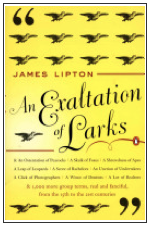 Some decades ago the American poet and producer James Lipton revived interest in an old word tradition—giving fanciful names to groups of animals. An Exaltation of Larks explored how English hunters and word lovers in the fifteenth century pursued with imagination the collective names for the beasts they pursued in the woods with bow and arrow. Most of their terms died out as markers of class—intended to be used to show off superior breeding—while a few slipped into common usage; today we still speak of a “pride of lions” and “gaggle of geese” as well as a “school of fish.” Lipton introduced readers to many more. A “richness of martens,” a “murder of crows,” and “an unkindness of ravens” show feelings both positive and negative projected onto animals while a “tower of giraffes” and an “ostentation of peacocks” play with appearance. And then there are the nouns suggesting behavior, by far the largest group: a “skulk of foxes,” a “leap of leopards,” a “murmuration of starlings.”
Some decades ago the American poet and producer James Lipton revived interest in an old word tradition—giving fanciful names to groups of animals. An Exaltation of Larks explored how English hunters and word lovers in the fifteenth century pursued with imagination the collective names for the beasts they pursued in the woods with bow and arrow. Most of their terms died out as markers of class—intended to be used to show off superior breeding—while a few slipped into common usage; today we still speak of a “pride of lions” and “gaggle of geese” as well as a “school of fish.” Lipton introduced readers to many more. A “richness of martens,” a “murder of crows,” and “an unkindness of ravens” show feelings both positive and negative projected onto animals while a “tower of giraffes” and an “ostentation of peacocks” play with appearance. And then there are the nouns suggesting behavior, by far the largest group: a “skulk of foxes,” a “leap of leopards,” a “murmuration of starlings.”
Recently, during some way-too-busy weeks of an overwhelming workload and too many unknowns looming, I slipped away one sunny morning to the Boulder reservoir, hoping to see eagles. Bald eagles begin nesting here in February, and although the reservoir this year was still capped with a solid lid of ice, I hoped perhaps the eagles would perch nearby even if they would not likely find a decent breakfast between its shores.
I parked near the reservoir and began hiking. Read More…